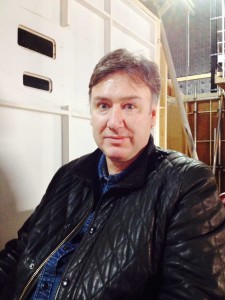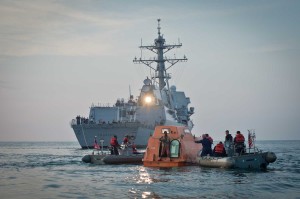
Director Paul Greengrass met production designer Paul Kirby on the set of his 2010 film Green Zone. Their experience together was so successful they decided to repeat it on Captain Phillips, the true story of Captain Richard Phillips (Tom Hanks), the commanding officer of a U.S. Cargo ship that was hijacked by a crew of Somali pirates.
Kirby found that everything he had learned on his prior collaboration with the director was helpful on Captain Phillips. “With Greengrass’ films, you have to start with reality,” Kirby said. “It’s not a sort of work where design is front and center stage. It’s an invisible role but no less satisfying. It’s very much about understanding how the director films, the way the camera works.”
When it came to filming the thriller that occurs on the high seas, motive was everything. Following the director’s cue, Kirby allowed motive to rule his every choice. “The director was not interested in aesthetics for its own sake,” explained the production designer. “People can get that from watching his films. It’s not beauty for beauty’s sake. It’s all about the motive. With Greengrass’ films, you’re next to the main character and with most of his films, you’ll stay with the main character. You feel what they feel. You see what they see all the way through. The camera’s always moving. The camera reacts like your pair of eyes, picking up all the details.”

Greengrass’ way of shooting scenes, of using movement to follow characters’ journeys thoroughly dictated the way his production designer needed to plan the sets. “I learned very early on in Green Zone that if you have a scene where you’re static in an office, that scene would never just be the office,” Kirby said. “It’d start outside the corridor, pick up on the stairs, to the office. And [the characters] would be walking and talking rather than sitting. You don’t just plan a set of a location. You have to plan a journey. There’s always a journey. You have to plot the journey on how the story develops.”
On Captain Phillips the journey began with the ship which was actually the sister ship to the actual ship on which the real life incident took place.
“We made some alterations to the interiors, like putting in mirrors to open up space, some of the rooms weren’t quite what you’d expect, like the captain’s quarters, so we changed some of the furniture to make it look more special,” explained Kirby. The story itself unfolds within the ship and here motive is displayed in all the minute details. “Sometimes, of course, an actual reality and the film reality aren’t quite the same and in order to press home an immersion, a feeling, the set might have to be a way that isn’t actually the case. So you may make a corridor narrower to make it more dramatic, claustrophobic.”
This technique assisted in giving the film a more documentary look fueling the realistic feel as the high seas thriller unfolds.





